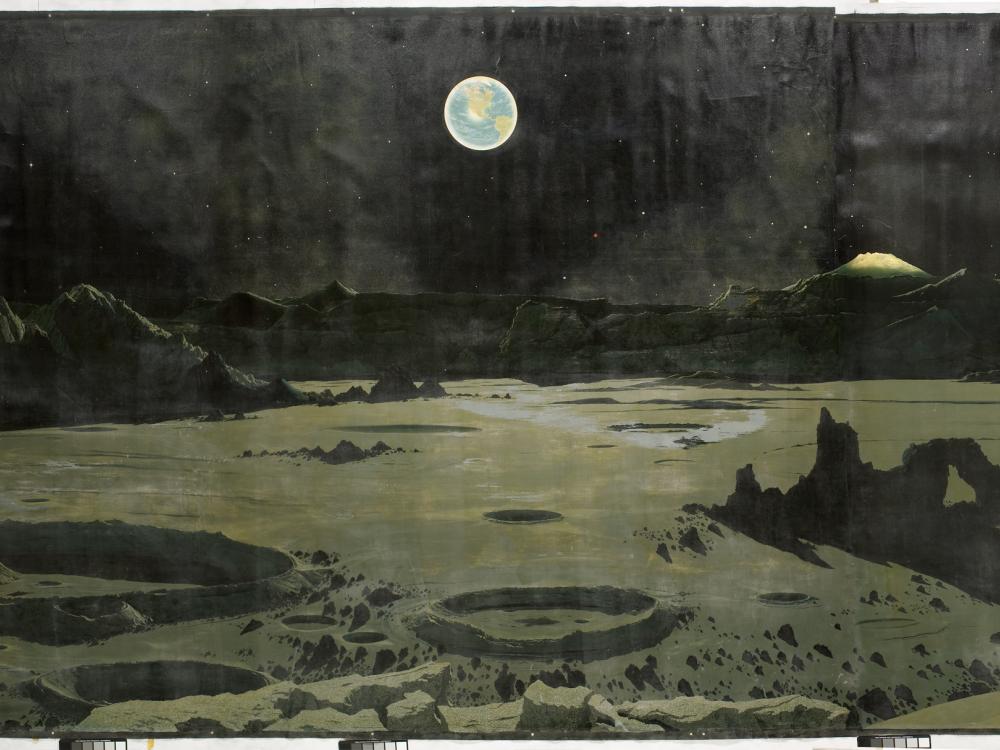
A Lunar Landscape
Before humans went to the Moon, Chesley Bonestell imagined the surface of the Moon with his masterpiece A Lunar Landscape. On March 28, 1957—six months before Sputnik launched—the Museum of Science in Boston unveiled the work of art on the lobby wall of the Charles Hayden Planetarium.
A Lunar Landscape helped viewers imagine what it would be like to stand on another world. Given that there was little factual information available about what the surface of the Moon looked like, Bonestell took artistic license with his subject and presented a dramatically lit moonscape with sharp peaks, jagged canyons, and precipitous crater walls.

Chesley Bonestell (1888-1986) grew up in San Francisco, surviving the 1906 earthquake. He became a leading architectural designer and left his mark on iconic structures such as the U.S. Supreme Court and the Golden Gate Bridge. His matte paintings provided a stunning backgrounds for Hollywood films of the 1930s and '40s, including Citizen Kane. However, he remains best know for his profound influence on a generation of space enthusiasts, whose dreams were fueled by his images.
On February 20th, 1965, the Ranger 8 spacecraft crashed into the Moon. Rapidly transmitting a series of pictures to ground controllers, its camera recorded this one at an altitude of about 11 kilometers, 5 seconds before impacting the lunar surface. Two kilometers across, with 4 meter sized objects visible, the picture is of an area in the Sea of Tranquillity north of the Apollo 11 landing site. The Ranger spacecraft represented the first attempts by the US to obtain high resolution photos of the Moon, flying a crash course toward selected areas and sending back pictures until the moment of impact.
Photos taken by the first lunar probes, such as the Ranger spacecraft, showed a very different place than in A Lunar Landscape. They revealed a gentler, far less dramatic world than Bonestell had envisioned. Recognizing that the mural could no longer be considered accurate, officials at the Museum of Science, Boston removed it from display in 1970.
“I tried to make it as dramatic as I could,” Bonestell explained, while admitting that the Moon looked “nothing like” his masterpiece. Soft rolling hills, he said, “wouldn’t have looked very interesting.”
Artist Ron Miller suggests that Bonestell painted the Moon “as it should have been.” A Lunar Landscape remains a masterful, if outdated, vision from a time when people could only dream of space travel.

Object Highlight
While A Lunar Landscape inspired awe with its imaginative moonscape, the Boston Museum of Science officials carefully removed it from the wall in 1970 when lunar probes provided images of a more accurate lunar landscape. They presented the artwork to the National Air and Space Museum six years later.
After the Museum of Science, Boston removed A Lunar Landscape from display in 1970, it remained unseen for over thirty years. Finally, in July 2005, museum staff gathered at the Smithsonian’s Museum Support Center to witness the mural’s unrolling. However, it would not be until 2022 that the mural was fully restored and returned to display in the Museum's Destination Moon exhibit.
Jia–sun Tsang, senior paintings conservator at the Smithsonian’s Museum Conservation Institute, surveyed the painting with her team to determine how it had fared rolled up for three decades. The mural showed some telling signs of age, but nothing that conservation work could not fix. Outside layers of the roll (mostly the left section) showed some discoloration. But aside from minor flaking, the rest of the mural was in good condition. After two days of examination, the mural was carefully re–rolled. To restore the mural for display, a team needed to unroll it again, stretch the canvas over many months, and then mount it on an aluminum frame.